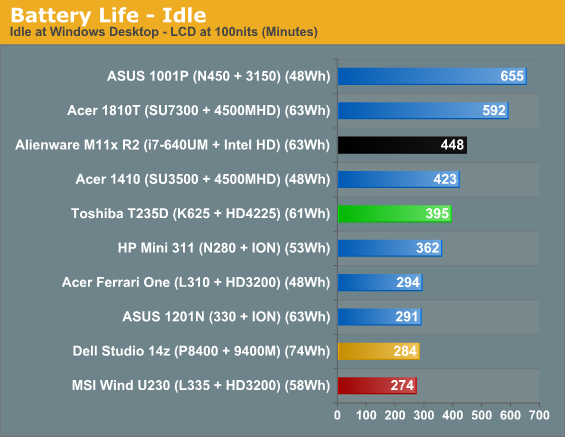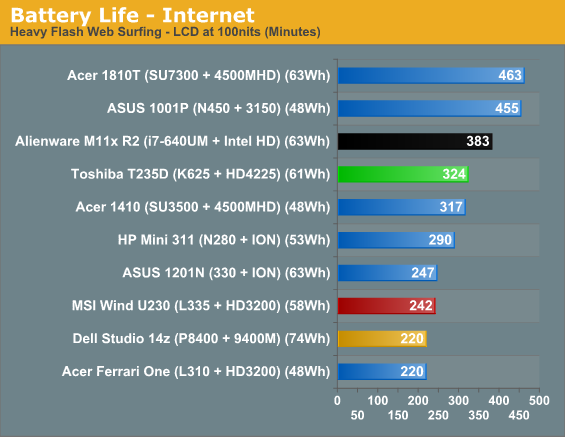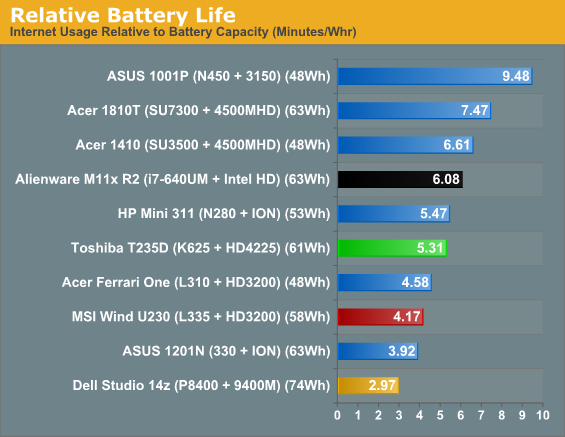Toshiba T235D: AMD's 2010 Ultrathin "Nile" Platform
by Jarred Walton on August 23, 2010 11:00 PM ESTAMD Nile: Improving Battery Life
We've railed on AMD's battery life in previous reviews, and rightly so. If you can't build a faster laptop than Intel, and pricing isn't significantly better, you need to at least offer comparable battery life. The T235D addresses all of these areas to varying degrees, but let's look at battery life specifically. Thankfully, Toshiba includes a larger-than-normal 61Wh battery with the T235D, which puts it in direct contention with the 63Wh batteries of the M11x and the Acer 1810T.




So, we're still not at the 8+ hours that CULV laptops get, but we're finally hitting 6.5 hours in our idle test and around 5.5 hours in our Internet test; you can even last long enough for nearly two full-length movies (just shy of four hours). For a thin and light laptop, that's definitely acceptable. If we factor in battery capacities, the Acer 1810T is still our leader (at least, our leader after Atom), with 15% to 45% more life per Wh than the T235D. Switch to the M11x R2 and it's a lot closer: the two contestants are tied in x264 playback, while the M11x leads by 10% to 15% in the idle and internet results.
As for the old Congo platform, if we compare based on relative battery life (i.e. factoring in battery capacity), the T235D beats the smaller Ferrari One by 6% to 24%. The difference between the T235D and the U230 is even greater: 27% higher Internet life and 37% more Idle/x264 run-time. All it would take is something like the ASUS UL series' 84Wh batteries and the T235D could reach around nine hours of mobility.
One final note is that the battery in the T235D says it's a 61Wh model in one place, but it also lists a voltage of 10.8V and 5300mAh. Multiply those out to get the wattage and it looks like the battery would be better classified as a 57Wh 6-cell, which would improve our relative battery life measurement from 5.31 up to 5.68. (Oddly enough, the online specs list the T235D as coming with a 48Wh battery; we're not sure if we got a "special" battery or if the spec pages are simply wrong, but hopefully it's the latter.) Of course, battery capacities are a bit tricky—I know I have some 2500mAh 1.2V AA Energizer rechargeable batteries that suck compared to some equivalently rated 2500mAh Eneloop rechargeables. Without a lot more detail on the internal workings of the batteries all we have to go off are the manufacturer ratings on the back, as well as our real-world battery life test results.










34 Comments
View All Comments
The Crying Man - Tuesday, August 24, 2010 - link
Good to know! Shame HP isn't sending laptops your guys' way. I'm pretty wary of buying Toshiba with their policy regarding Catalyst drivers. I don't know if it's the same for nVidia, but I'm an AMD fanboy anyway.JarredWalton - Tuesday, August 24, 2010 - link
Funny thing is that HP *is* sending us some laptops now... but they're all from the business lines. We're having more difficulty getting the consumer laptops from them, but we hope to have an ENVY 14 sometime soon.LoneWolf15 - Tuesday, August 24, 2010 - link
I'm excited by AMD's new mobile processor/IGP solutions.I'm not excited by Toshiba and their implementation. Swirly and cheesy-looking palmrest that I'd never carry into a meeting if I wanted respect. Tons of annoying advertising palmrest stickers I'd need to scrape off and clean before they come off on their own and leave a sticky mess. Toshiba not participating in the AMD/ATI Catalyst program, and finally, Toshiba's penchant for massive bloatware in the form of Toshiba-branded notebook utilities that rob performance and make it difficult for an average user to know what is and isn't necessary.
I'll wait for a version of this platform as implemented by someone else.
Gigantopithecus - Tuesday, August 24, 2010 - link
Thanks for the review, Jarred. It's nice to have an AMD-based notebook that I can recommend to friends; undoubtedly there will be more aesthetically modest models in the future. This specific model seems particularly well-suited for the college crowd (especially since they'll want a laptop asap and not want to wait for Bobcat). In the future, it would be useful to have temperature data - just a few readings from various parts of the system (i.e. palm rest, underside of chassis) are sufficient.JarredWalton - Tuesday, August 24, 2010 - link
I tend to only report temperature and noise information if it's out of the norm. This laptop runs pretty close to room temperature most of the time, and even under full load it's never very loud. Give me an hour or so of "warm up" time and I'll report back with specific figures here. :-)JarredWalton - Tuesday, August 24, 2010 - link
Page six is now updated with temperature and noise data. Note that I'm the only one of our laptop team with an SPL meter and digital thermometer, so we likely won't be able to provide such results on all of our reviews (unless there's enough demand for it that we decide to buy more test equipment).LesMoss - Tuesday, August 24, 2010 - link
A suggestion: For relative battery life, use minutes per pound as the metric. That way you don't care how good the manufactuers Wh rating is.Souka - Tuesday, August 24, 2010 - link
It's a cute laptop....good for my Mom, except the LCD...bummer :(Souka - Tuesday, August 24, 2010 - link
LCD Quality I mean. Size & resolution is fine.josephandrews222 - Tuesday, August 24, 2010 - link
...I wonder if you would take a moment and compare this Toshiba (T235D) with the Toshiba Protege 700/705.The 705 is about $300.00 more than the T235D, right?
But I sure like the looks of it...and altho it is subjective I think the 705 may be worth the extra dough.
Your view?